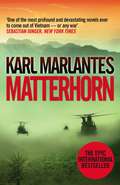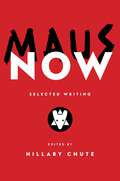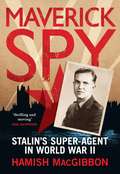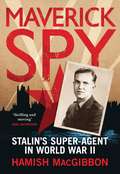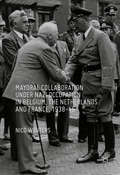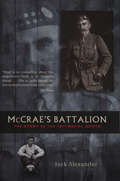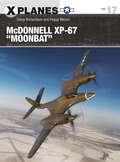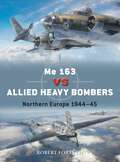- Table View
- List View
Matterhorn: A Novel Of The Vietnam
by Karl MarlantesWINNER OF THE FLAHERTY-DUNNAN FIRST NOVEL PRIZEFire Support Base Matterhorn: a fortress carved out of the grey-green mountain jungle. Cold monsoon clouds wreath its mile-high summit, concealing a battery of 105-mm howitzers surrounded by deep bunkers, carefully constructed fields of fire and the 180 marines of Bravo Company. Just three kilometres from Laos and two from North Vietnam, there is no more isolated outpost of America's increasingly desperate war in Vietnam.Second Lieutenant Waino Mellas, 21 years old and just a few days into his 13-month tour, has barely arrived at Matterhorn before Bravo Company is ordered to abandon their mountain and sent deep in-country in pursuit of a North Vietnamese Army unit of unknown size. Beyond the relative safety of the perimeter wire, Mellas will face disease, starvation, leeches, tigers and an almost invisible enemy. Beneath the endless jungle canopy, Bravo Company will confront competing ambitions, duplicitous officers and simmering racial tensions. Behind them, always, Matterhorn. The impregnable mountain fortress they built and then abandoned, without a shot, to the North Vietnamese Army...
Matthew Hawkwood Thriller Series Books 1-3: Ratcatcher, Resurrectionist, Rapscallion
by James McGeeThe Sunday Times bestselling historical thrillers. Meet Matthew Hawkwood: soldier, spy, lover. A man as dangerous as the murderers, spies and traitors he hunts on the crime-ridden streets of London at the height of the Napoleonic wars.
Mau-Mau Warrior (Warrior)
by Christa Hook Abiodun AlaoThe Mau-Mau uprising (1952-60) remains a controversial conflict, waged by warriors about whom many myths have been formed, but little truth has been written. Condemned by history as a brutal rag-tag force engaged in oath-taking, cannibalism and witchcraft, the military activities of the Mau-Mau have long been overlooked. Although their skill, organization and unique motivation forced the British government to undertake the longest airlift in military history, and to deploy extensive force at a cost of almost £60 million, before it could claim victory. This book reveals the real men and women behind the Mau-Mau; the truth behind the oaths that bound them together; and how they became a powerful force, paving the way for Kenya's independence.
Mau-Mau Warrior (Warrior #108)
by Christa Hook Abiodun AlaoThe Mau-Mau uprising (1952-60) remains a controversial conflict, waged by warriors about whom many myths have been formed, but little truth has been written. Condemned by history as a brutal rag-tag force engaged in oath-taking, cannibalism and witchcraft, the military activities of the Mau-Mau have long been overlooked. Although their skill, organization and unique motivation forced the British government to undertake the longest airlift in military history, and to deploy extensive force at a cost of almost £60 million, before it could claim victory. This book reveals the real men and women behind the Mau-Mau; the truth behind the oaths that bound them together; and how they became a powerful force, paving the way for Kenya's independence.
Maus Now: Selected Writing
by Art Spiegelman Hillary ChuteA richly illustrated book in which leading cultural critics, authors, and academics reflect on the radical achievement and innovation of Art Spiegelman's Pulitzer Prize-winning masterpiece Maus'The most affecting and successful narrative ever done about the Holocaust' Wall Street Journal___________________________________________________________________________It is hard to overstate Art Spiegelman's effect on postwar American culture. The Pulitzer Prize-winning author is one of our most influential contemporary artists, and his masterpiece Maus has shaped the fields of literature, history, and art. Collecting responses to the work that confirm its unique and terrain-shifting status, Maus Now is a new collection of essays that sees writers such as Philip Pullman, Robert Storr, Ruth Franklin, and others approaching the complexity of Maus from a wide range of viewpoints and traditions.Offering translations of important French, Hebrew, and German essays on Maus for the first time, this collection edited by American literary scholar Hillary Chute - an expert on comics and graphic narratives - assembles the world's best writing on this classic work of graphic testimony.___________________________________________________________________________'The first masterpiece in comic book history' The New Yorker on Maus'No summary can do justice to Spiegelman's narrative skill' Adam Gopnik on Maus'Like all great stories, it tells us more about ourselves than we could ever suspect' Philip Pullman on Maus
Mauser Military Rifles (Weapon)
by Peter Dennis Neil Grant Alan GillilandThis volume offers an insight into the iconic Mauser family of German bolt-action rifles. Drawing on first-hand accounts of the weapons in combat and primary sources regarding their mechanical performance, this fully illustrated study charts the Mauser's origins, combat record and lasting influence. It explores the full range of Mauser rifles, beginning with the hugely successful Gew 98, which entered service in the time of the Kaiser, provided the basis for the US Springfield M1903 and equipped combatants such as the South African Boers. It also investigates the Kar 98k, which was still in front-line use with Wehrmacht troops in 1945, saw use with Mexican and Yugoslavian forces, and even played a role in the 1990s Balkan conflicts in the hands of snipers. Featuring expert analysis, specially commissioned artwork and gripping first-hand accounts, this volume is ideal for anyone seeking an understanding of these sturdy and accurate rifles' unique place in the history of small-unit tactics in the 20th century.
Mauser Military Rifles (Weapon)
by Peter Dennis Neil Grant Alan GillilandThis volume offers an insight into the iconic Mauser family of German bolt-action rifles. Drawing on first-hand accounts of the weapons in combat and primary sources regarding their mechanical performance, this fully illustrated study charts the Mauser's origins, combat record and lasting influence. It explores the full range of Mauser rifles, beginning with the hugely successful Gew 98, which entered service in the time of the Kaiser, provided the basis for the US Springfield M1903 and equipped combatants such as the South African Boers. It also investigates the Kar 98k, which was still in front-line use with Wehrmacht troops in 1945, saw use with Mexican and Yugoslavian forces, and even played a role in the 1990s Balkan conflicts in the hands of snipers. Featuring expert analysis, specially commissioned artwork and gripping first-hand accounts, this volume is ideal for anyone seeking an understanding of these sturdy and accurate rifles' unique place in the history of small-unit tactics in the 20th century.
The Mauthausen Trial: American Military Justice in Germany
by Tomaz JardimShortly after 9:00 a.m. on May 27, 1947, the first of forty-nine men condemned to death for war crimes at Mauthausen concentration camp mounted the gallows at Landsberg prison near Munich. The mass execution that followed resulted from an American military trial conducted at Dachau in the spring of 1946—a trial that lasted only thirty-six days and yet produced more death sentences than any other in American history. The Mauthausen trial was part of a massive series of proceedings designed to judge and punish Nazi war criminals in the most expedient manner the law would allow. There was no doubt that the crimes had been monstrous. Yet despite meting out punishment to a group of incontestably guilty men, the Mauthausen trial reveals a troubling and seldom-recognized face of American postwar justice—one characterized by rapid proceedings, lax rules of evidence, and questionable interrogations. Although the better-known Nuremberg trials are often regarded as epitomizing American judicial ideals, these trials were in fact the exception to the rule. Instead, as Tomaz Jardim convincingly demonstrates, the rough justice of the Mauthausen trial remains indicative of the most common—and yet least understood—American approach to war crimes prosecution. The Mauthausen Trial forces reflection on the implications of compromising legal standards in order to guarantee that guilty people do not walk free.
Maverick Holiday Magic (Montana Mavericks: Six Brides for Six Brother #5)
by Teresa SouthwickSanta brought a Nanny for Christmas!
Maverick One: The True Story of a Para, Pathfinder, Renegade
by David BlakeleyThe explosive sequel to the bestselling PATHFINDER.For the first time ever an elite British operator tells the gruelling story of his selection into the Pathfinders - Britain's secret soldiers. Pathfinder selection is a brutal physical and psychological trial lasting many weeks. It rivals that of the SAS and takes place over the same spine-crushing terrain, in the rain-and-snow-lashed wastes of the Welsh Mountains. For two decades no one has been able to relate the extraordinary trials of British elite forces selection - until now.Captain David Blakeley goes on from completing selection to serve with the Pathfinders in Afghanistan post 9/11, where he had a gun held to his head by Al Qaeda fighters. From there he deploys to Iraq, on a series of dramatic behind- enemy-lines missions - wherein he and his tiny elite patrol are outnumbered, outgunned and trapped. Maverick One is unique and extraordinary, chronicling the making of a warrior. It culminates in Blakeley fighting back to full recovery from horrific injuries suffered whilst on operations in Iraq, to go on to face SAS selection.
Maverick Spy: Stalin's Super-Agent in World War II
by Hamish MacGibbonAt the end of the war MI5 suspected him of espionage and interrogated him but he did not confess. Nevertheless they kept James, his wife Jean and their young family under close surveillance for a number of years, regularly intercepting their mail and recording their telephone conversations. Only after James's death did the true significance of what he might have revealed become clear-in his wartime office role, James had access to the plans for Operation Overlord, D-Day. In this book, James's son Hamish tells the story of his parents, their interaction with the communist party and their flirtation with wartime espionage. It is a unique portrait of two very ordinary people caught up in the extraordinary events of World War Two and the Cold War.
Maverick Spy: Stalin's Super-Agent in World War II
by Hamish MacGibbonA few years before he died James MacGibbon confessed to his close family that he had spied for the Soviet Union during World War II. At the end of the war MI5 suspected him of espionage and interrogated him but he did not confess. Nevertheless they kept James, his wife Jean and their young family under close surveillance for a number of years, regularly intercepting their mail and recording their telephone conversations. Only after James's death did the true significance of what he might have revealed become clear – in his wartime office role, James had access to the plans for Operation Overlord, D-Day. In this book, James's son Hamish tells the story of his parents, their interaction with the communist party and their flirtation with wartime espionage. It is a unique portrait of two very ordinary people caught up in the extraordinary events of World War Two and the Cold War.
Max Hastings Two-Book Collection: All Hell Let Loose and Catastrophe
by Max HastingsA two-book collection of Max Hastings’ bestselling works about the 20th century’s most terrible global conflicts.
Max Weber's Vision for Bureaucracy: A Casualty of World War I
by Glynn CochraneThis volume examines Max Weber’s pre-World War I thinking about bureaucracy. It suggests that Weber’s vision shares common components with the highly efficient Prussian General Staff military bureaucracy developed by Clausewitz and Helmuth von Moltke. Weber did not believe that Germany’s other major institutions, the Civil Service, industry, or the army could deliver world class performances since he believed that they pursued narrow, selfish interests. However, following Weber’s death in 1920, the model published by his wife Marianne contained none of the military material about which Weber had written approvingly in the early chapters of Economy and Society. Glynn Cochrane concludes that Weber’s model was unlikely to include military material after the Versailles peace negotiations (in which Weber participated) outlawed the Prussian General Staff in 1919.
Maybe This Kiss (Colorado Ice #1)
by Jennifer SnowLove is always worth the risk . . . Neil Healy was happy to be promoted to Air Force lieutenant colonel, but he's less than thrilled that the new job has brought him back to his hometown. The memories alone could kill a man, to say nothing of actually seeing the woman he never got over. Neil knew avoiding Becky Westmore would be impossible, but he didn't expect the chemistry between them to be as strong as ever.All Becky wants this holiday season is to get through the month of December with her sanity intact. Not helping? Her ex-boyfriend's return to Glenwood Falls. Even after a decade apart, Neil still makes her feel in ways no other man has. But Christmas is a time for miracles, and maybe Becky's will be a second chance at first love.***The Colorado Ice seriesMaybe This KissMaybe This TimeMaybe This LoveMaybe This SummerMaybe This Christmas
Maybe This Kiss (Colorado Ice #1)
by Jennifer SnowLove is always worth the risk . . . Neil Healy was happy to be promoted to Air Force lieutenant colonel, but he's less than thrilled that the new job has brought him back to his hometown. The memories alone could kill a man, to say nothing of actually seeing the woman he never got over. Neil knew avoiding Becky Westmore would be impossible, but he didn't expect the chemistry between them to be as strong as ever. All Becky wants this holiday season is to get through the month of December with her sanity intact. Not helping? Her ex-boyfriend's return to Glenwood Falls. Even after a decade apart, Neil still makes her feel in ways no other man has. But Christmas is a time for miracles, and maybe Becky's will be a second chance at first love.
Mayoral Collaboration under Nazi Occupation in Belgium, the Netherlands and France, 1938-46
by Nico WoutersThis book explores the role of mayors in navigating the realities of living and governing under Nazi occupation. In Western Europe under Nazi occupation, mayors of villages and cities were forced into strategic cooperation with the occupier. Mayors had to provide good governance, mediate between occupier and populations, maintain personal legitimacy, and build local consensus. However, as national systems underwent authoritarian reform and collaborationists infiltrated administrations, local governments were gradually turned into instruments of Nazi control and repression. Nico Wouters uses rich new archival data to compare the realities of local government in three countries. Looking at topics such as food supply, public order and safety, forced labour, the repression of resistance, the persecution of the Jews and post-war purges, this book redefines our knowledge of collaboration, resistance and accommodation during Nazi occupation.
McCrae's Battalion: The Story of the 16th Royal Scots
by Jack AlexanderMcCrae's Own was the 'Heart of Midlothian Battalion' mentioned all too briefly in Martin Middlebrook's classic book The First Day on the Somme. Raised in Edinburgh shortly after the start of the Great War, it was perhaps the finest unit in Lord Kitchener's volunteer army - a brotherhood of sportsmen, bound together by their extraordinary colonel and their loyalty to a quaintly named Association Football club, the famous Gorgie 'Hearts'. McCrae's were blooded in the Battle of the Somme, losing three-quarters of their strength on the first day alone. The Colonel himself was invalided home. In time the battalion recovered. It came of age at Arras, endured the muddy horror of Passchendaele, and held the line unbroken in the face of furious German attacks on the Lys in 1918. For almost a century their story remained untold. It was all but lost forever. Now, after 12 years of exacting historical detective work, Jack Alexander has reclaimed the 16th Royal Scots for posterity. In this stirring book he draws upon interviews with veterans and a unique archive of letters, diaries and photographs, assembled from the families of more than 1,000 of Sir George McCrae's men.
McDonnell Douglas Phantom- Two-Seat All-weather Interceptor and Ground-attack Fighter (large print)
by RnibThis is an image of a jet fighter aircraft seen from above. There is a locator dot shown, which will be at the top left of the page when the image is the correct way up. The image is in the centre and a scale in metres on the left of the page. The aircraft nose is in the top centre and the tail in the bottom centre of the page. The fuselage goes up and down the middle of the page. The cockpit cover is shown as an oval near the nose. There is the intake of a jet engine to the left and right of the cockpit. The wings sweep down to the left and right. The wings each have one fuel tank sticking out on the front edge and two ailerons on the rear edge. These are the ailerons used to manoeuvre the aircraft when it is flying. At the bottom of the page in the centre of the fuselage is the vertical tail. To each side of this is the tailplane. Just up from the tailplane, to the left and right, are the jet exhaust nozzles.
McDonnell Douglas Phantom- Two-Seat All-weather Interceptor and Ground-attack Fighter (UEB contracted)
by RnibThis is an image of a jet fighter aircraft seen from above. There is a locator dot shown, which will be at the top left of the page when the image is the correct way up. The image is in the centre and a scale in metres on the left of the page. The aircraft nose is in the top centre and the tail in the bottom centre of the page. The fuselage goes up and down the middle of the page. The cockpit cover is shown as an oval near the nose. There is the intake of a jet engine to the left and right of the cockpit. The wings sweep down to the left and right. The wings each have one fuel tank sticking out on the front edge and two ailerons on the rear edge. These are the ailerons used to manoeuvre the aircraft when it is flying. At the bottom of the page in the centre of the fuselage is the vertical tail. To each side of this is the tailplane. Just up from the tailplane, to the left and right, are the jet exhaust nozzles.
McDonnell Douglas Phantom- Two-Seat All-weather Interceptor and Ground-attack Fighter (UEB uncontracted)
by RnibThis is an image of a jet fighter aircraft seen from above. There is a locator dot shown, which will be at the top left of the page when the image is the correct way up. The image is in the centre and a scale in metres on the left of the page. The aircraft nose is in the top centre and the tail in the bottom centre of the page. The fuselage goes up and down the middle of the page. The cockpit cover is shown as an oval near the nose. There is the intake of a jet engine to the left and right of the cockpit. The wings sweep down to the left and right. The wings each have one fuel tank sticking out on the front edge and two ailerons on the rear edge. These are the ailerons used to manoeuvre the aircraft when it is flying. At the bottom of the page in the centre of the fuselage is the vertical tail. To each side of this is the tailplane. Just up from the tailplane, to the left and right, are the jet exhaust nozzles.
McDonnell XP-67 "Moonbat" (X-Planes)
by Steve Richardson Peggy MasonPacked with never-before-seen photos, plans and meticulous new digital artwork, this is the first history of the USAAF's futuristic World War II prototype interceptor, the XP-67 "Moonbat".The series of X-planes that sprang from the US Army's Request for Data R40C, focused on high-altitude, high-speed, long-range bomber interceptors. Among these aircraft was the McDonnell Aircraft Company's first ever clean sheet design, the XP67. Its futuristic lines promised performance that it was ultimately unable to deliver, but development was still underway when disaster struck. Just before Army performance demonstration flights were scheduled to begin, an engine fire destroyed the only XP-67 prototype, leaving a host of unanswered questions about what might have been, and leading to decades of continuing fascination with the XP-67 among aviation buffs and aircraft modelers.The authors of this book have uncovered new sources of information and a wealth of photographs and line drawings that document not just the XP-67 but also its immediate precursors within the McDonnell Aircraft design community, as well as alternative configurations for unbuilt variants aimed at different missions. Packed with unpublished photos of all stages of construction including key airframe changes made after initial flight tests, showing in detail how the final configuration was evolved, this volume finally provides clear focus on a story that has long been shrouded in mystery.
McDonnell XP-67 "Moonbat" (X-Planes)
by Steve Richardson Peggy MasonPacked with never-before-seen photos, plans and meticulous new digital artwork, this is the first history of the USAAF's futuristic World War II prototype interceptor, the XP-67 "Moonbat".The series of X-planes that sprang from the US Army's Request for Data R40C, focused on high-altitude, high-speed, long-range bomber interceptors. Among these aircraft was the McDonnell Aircraft Company's first ever clean sheet design, the XP67. Its futuristic lines promised performance that it was ultimately unable to deliver, but development was still underway when disaster struck. Just before Army performance demonstration flights were scheduled to begin, an engine fire destroyed the only XP-67 prototype, leaving a host of unanswered questions about what might have been, and leading to decades of continuing fascination with the XP-67 among aviation buffs and aircraft modelers.The authors of this book have uncovered new sources of information and a wealth of photographs and line drawings that document not just the XP-67 but also its immediate precursors within the McDonnell Aircraft design community, as well as alternative configurations for unbuilt variants aimed at different missions. Packed with unpublished photos of all stages of construction including key airframe changes made after initial flight tests, showing in detail how the final configuration was evolved, this volume finally provides clear focus on a story that has long been shrouded in mystery.
Me 163 vs Allied Heavy Bombers: Northern Europe 1944–45 (Duel #135)
by Robert ForsythAn illustrated account of the dramatic engagement between the Luftwaffe's Me 163 units and Allied bombers during the closing years of World War II.In the summer of 1944, US Army Air Force (USAAF) aircrews flying over the Third Reich reported observing small, high-speed 'batlike' aircraft flying close to their formations. The Luftwaffe's extraordinary Messerschmitt Me 163 rocket-powered interceptor was making its devastating debut with Jagdgeschwader (JG) 400. Capable of reaching high altitudes in the shortest possible time by using a volatile rocket fuel, the Me 163 was the Luftwaffe's most impressive yet dangerous aircraft, and the fastest in the world. Luftwaffe expert Robert Forsyth details the testing of the aircraft and its lethal SG 500 'Fighter Fist' weapons system, as well as its deployment against the B17s and B24s of the USAAF's Eighth Air Force and, from late 1944, the Lancasters and Halifaxes of RAF Bomber Command. These duels started a deadly form of warfare, with the bomber squadrons striking at Germany's synthetic oil refineries and jet airfields, and the Me 163s of JG 400 trying to stop them using cutting-edge aeronautical technology.Using specially commissioned artwork, original photographs and rare first-hand interviews with the pilots that fought the decisive dogfights, this exciting book describes the pivotal encounters over Northern Europe.
Me 163 vs Allied Heavy Bombers: Northern Europe 1944–45 (Duel #135)
by Robert ForsythAn illustrated account of the dramatic engagement between the Luftwaffe's Me 163 units and Allied bombers during the closing years of World War II.In the summer of 1944, US Army Air Force (USAAF) aircrews flying over the Third Reich reported observing small, high-speed 'batlike' aircraft flying close to their formations. The Luftwaffe's extraordinary Messerschmitt Me 163 rocket-powered interceptor was making its devastating debut with Jagdgeschwader (JG) 400. Capable of reaching high altitudes in the shortest possible time by using a volatile rocket fuel, the Me 163 was the Luftwaffe's most impressive yet dangerous aircraft, and the fastest in the world. Luftwaffe expert Robert Forsyth details the testing of the aircraft and its lethal SG 500 'Fighter Fist' weapons system, as well as its deployment against the B17s and B24s of the USAAF's Eighth Air Force and, from late 1944, the Lancasters and Halifaxes of RAF Bomber Command. These duels started a deadly form of warfare, with the bomber squadrons striking at Germany's synthetic oil refineries and jet airfields, and the Me 163s of JG 400 trying to stop them using cutting-edge aeronautical technology.Using specially commissioned artwork, original photographs and rare first-hand interviews with the pilots that fought the decisive dogfights, this exciting book describes the pivotal encounters over Northern Europe.
